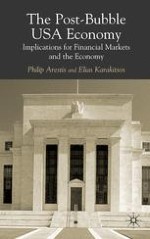2004 | OriginalPaper | Chapter
The Causes and Consequences of the Post-‘New Economy’ Bubble
Authors : Philip Arestis, Elias Karakitsos
Published in: The Post-Bubble US Economy
Publisher: Palgrave Macmillan UK
Included in: Professional Book Archive
Activate our intelligent search to find suitable subject content or patents.
Select sections of text to find matching patents with Artificial Intelligence. powered by
Select sections of text to find additional relevant content using AI-assisted search. powered by
On 26 November 2001 the National Bureau of Economic Research declared that the US economy’s recession had begun in March 2001. The expansion had lasted for ten years and it was one of the longest ever recorded by any industrialised country. In the fourth quarter of 1999 the US growth rate reached 7%, the highest in the 1990s. Unemployment fell to a 30-year low (3.9% by April 2000), the rate of inflation was low (averaged 2.5% throughout the whole of 1990s), faster growth in productivity was recorded, and faster growth in real wages. All these factors helped to reduce poverty and stabilise wage inequality (Temple, 2002). More recent data (see Council of Economic Advisors, 2004, table A33), though, reveal that this is true only for the years 1998–2001. The stock market also produced massive gains, so that by the late 1990s the price/earnings ratios reached record levels in the whole of the twentieth century. Every year between 1995 and 1999 the US stock exchange Standard and Poor’s Composite Index (S&P 500) produced an annualised total return (including dividends) over 20%. By the end of that period, the performance of the stock market was concentrated in the stocks of large companies and of growth companies (those that had been delivering strong growth in earnings per share and were expected to continue to do so), especially so in the areas of Technology, Media and Telecommunications (TMT). The Nasdaq Composite Index, which was a heavy representative in technology shares, reached the level of 2000 for the first time during 1998 and peaked to 5048 on 10 March 2000.
